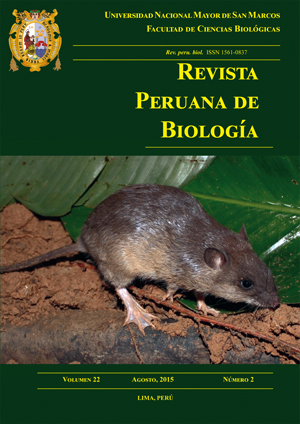Use and competition for food plants between Pithecia aequatorialis (Primates: Pitheciidae) and other animals in the Peruvian Amazonia
DOI:
https://doi.org/10.15381/rpb.v22i2.11356Keywords:
Primates, Pithecia aequatorialis, food plants, ingested parts, competitors.Abstract
In this report, we provide information on food plants of the equatorial saki (Pithecia aequatorialis) and its competitors in highland forest of the micro-watershed of the Itaya River, Peruvian Amazonia. From May to November 2009 and from January to April 2010 we followed silently two family groups with the purpose to identify plants whose fruits are part of their diet. During the contacts we had 90 food events in 48 plant species grouped in 24 families. Of these, 36 live in low hill forest and the rest in high terrace forest. The highest diversity of food plants is grouped into seven families that together accounted for 60.4%, among them Moraceae (8 species), Fabaceae (6 species) and Annonaceae (4 species) families. The fruits were mostly eaten in ripe state, being the mesocarp the most appreciated (40%). Among mammals, seven of the competitors were primates, with the main competitor being the red-mantled saddle-back tamarin (Saguinus lagonotus) and among birds the White-throated toucan (Ramphastos tucanus). Finally, the fruits of Pseudolmedia laevigata (Moraceae) were the most preferred by competitors (7 species of mammals and 2 of birds).Downloads
Downloads
Published
Issue
Section
License
Copyright (c) 2015 Elvis J. Charpentier J. Charpentier, Gabriel García, Rolando Aquino

This work is licensed under a Creative Commons Attribution-NonCommercial-ShareAlike 4.0 International License.
AUTHORS RETAIN THEIR RIGHTS:
a. Authors retain their trade mark rights and patent, and also on any process or procedure described in the article.
b. Authors retain their right to share, copy, distribute, perform and publicly communicate their article (eg, to place their article in an institutional repository or publish it in a book), with an acknowledgment of its initial publication in the Revista Peruana de Biologia.
c. Authors retain theirs right to make a subsequent publication of their work, to use the article or any part thereof (eg a compilation of his papers, lecture notes, thesis, or a book), always indicating its initial publication in the Revista Peruana de Biologia (the originator of the work, journal, volume, number and date).


















